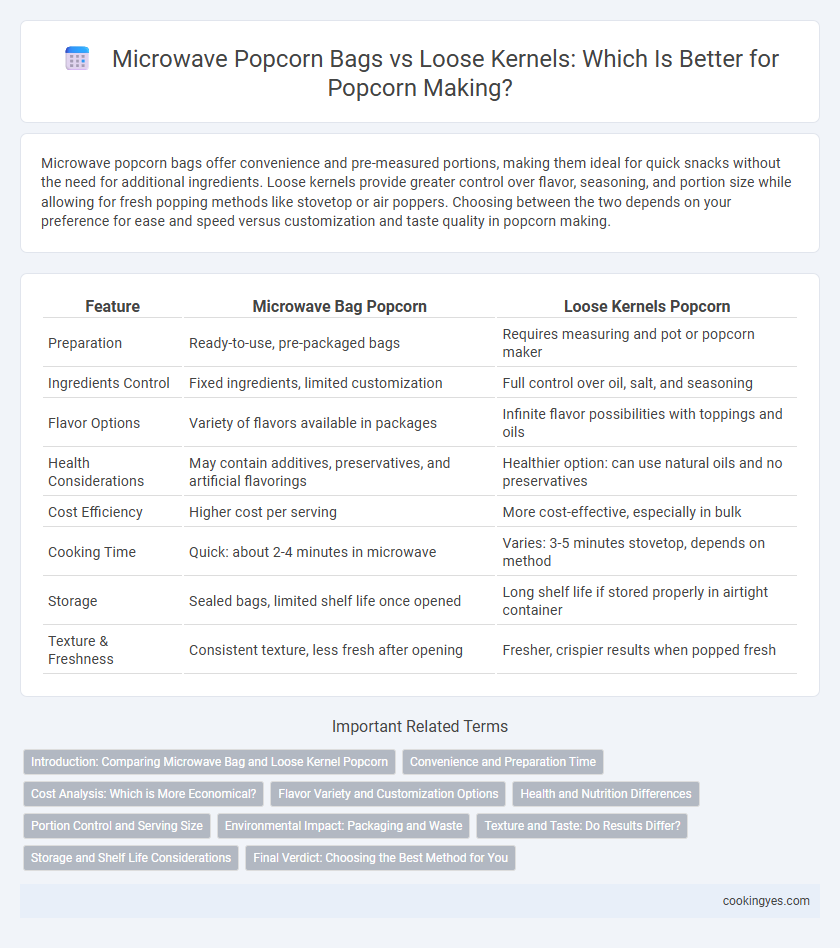Microwave popcorn bags offer convenience and pre-measured portions, making them ideal for quick snacks without the need for additional ingredients. Loose kernels provide greater control over flavor, seasoning, and portion size while allowing for fresh popping methods like stovetop or air poppers. Choosing between the two depends on your preference for ease and speed versus customization and taste quality in popcorn making.
Table of Comparison
| Feature | Microwave Bag Popcorn | Loose Kernels Popcorn |
|---|---|---|
| Preparation | Ready-to-use, pre-packaged bags | Requires measuring and pot or popcorn maker |
| Ingredients Control | Fixed ingredients, limited customization | Full control over oil, salt, and seasoning |
| Flavor Options | Variety of flavors available in packages | Infinite flavor possibilities with toppings and oils |
| Health Considerations | May contain additives, preservatives, and artificial flavorings | Healthier option: can use natural oils and no preservatives |
| Cost Efficiency | Higher cost per serving | More cost-effective, especially in bulk |
| Cooking Time | Quick: about 2-4 minutes in microwave | Varies: 3-5 minutes stovetop, depends on method |
| Storage | Sealed bags, limited shelf life once opened | Long shelf life if stored properly in airtight container |
| Texture & Freshness | Consistent texture, less fresh after opening | Fresher, crispier results when popped fresh |
Introduction: Comparing Microwave Bag and Loose Kernel Popcorn
Microwave bag popcorn offers convenience with pre-measured kernels and built-in seasoning for quick preparation, making it ideal for busy individuals. Loose kernel popcorn allows full control over kernel quantity, oil type, and seasoning, resulting in a customizable and often healthier snack experience. Comparing these methods highlights trade-offs in taste, nutrition, cost, and environmental impact.
Convenience and Preparation Time
Microwave popcorn bags offer unmatched convenience and significantly reduce preparation time, as they require no additional equipment or seasoning. Loose kernels demand a stovetop or popcorn maker, along with oil and seasoning, increasing both effort and total time before serving. Choosing microwave bags supports quick, hassle-free snacking, while loose kernels allow for customization at the expense of longer preparation.
Cost Analysis: Which is More Economical?
Microwave popcorn bags typically cost between $0.25 and $0.50 per bag, offering convenience but at a higher price per serving compared to loose kernels, which average around $2 to $4 per pound and yield approximately 40 to 50 cups of popcorn. When comparing cost per serving, loose kernels amount to about $0.05 to $0.10, making them significantly more economical for frequent popcorn makers. Bulk purchasing of loose kernels further reduces the cost, while microwave bags add expenses through packaging and flavoring materials.
Flavor Variety and Customization Options
Microwave popcorn bags offer convenience with pre-flavored varieties like butter, cheese, and caramel, but they limit customization and often contain additives. Loose kernels provide greater flavor flexibility, allowing users to experiment with seasoning blends, oil types, and cooking methods for a personalized taste experience. Choosing loose kernels supports a broader range of flavor creativity, catering to individual preferences and dietary considerations.
Health and Nutrition Differences
Microwave popcorn bags often contain added preservatives, artificial flavorings, and hydrogenated oils that can increase calorie and sodium intake compared to loose kernels. Popping loose kernels in an air popper or on the stove allows control over added fats, resulting in a healthier snack with fewer additives and lower saturated fat content. Nutritionally, loose-kernel popcorn retains more natural fiber and antioxidants, making it a better option for those seeking whole-food benefits without chemical additives.
Portion Control and Serving Size
Microwave popcorn bags offer precise portion control with pre-measured kernels, typically yielding one standard serving per bag, ideal for calorie-conscious consumers. Loose kernels allow flexibility in serving size, enabling customization for individual or group preferences, but require measuring tools for accurate portioning. Choosing between these options depends on whether convenience or tailored portion sizes are prioritized during popcorn preparation.
Environmental Impact: Packaging and Waste
Microwave popcorn bags generate significantly more waste due to their multi-layer packaging, often containing non-recyclable materials like plastic and aluminum, which contribute to landfill accumulation. Loose kernels produce less packaging waste as they typically come in recyclable or minimal packaging, reducing environmental impact. Choosing loose kernels for popcorn making supports sustainability by minimizing plastic use and promoting recyclable or compostable packaging options.
Texture and Taste: Do Results Differ?
Microwave popcorn bags often produce a consistent texture with fewer unpopped kernels due to engineered heat distribution, while loose kernels tend to deliver a fresher, richer taste and a more customizable crunch when popped in an air popper or stovetop. The oil and seasoning in microwave bags can affect flavor uniformity but sometimes mask the natural corn sweetness found in loose kernels. Texture differences are notable, with microwave popcorn usually softer and less crispy compared to the drier, crispier bite of freshly popped loose kernels.
Storage and Shelf Life Considerations
Microwave popcorn bags are pre-packaged with oils and seasonings, which can reduce their shelf life to around 6 to 9 months due to potential rancidity. Loose popcorn kernels, when stored in airtight containers in a cool, dry place, can last up to 1 to 2 years without losing popping quality. Proper storage of loose kernels prevents moisture absorption, ensuring consistent popping results and extended usability compared to microwave bags.
Final Verdict: Choosing the Best Method for You
Microwave popcorn bags offer convenience and consistent flavor with pre-measured kernels and seasoning, while loose kernels provide greater control over popping time, seasoning variety, and often result in fresher, larger popcorn. Choosing the best method depends on your priorities for ease versus customization and taste preferences, as microwave bags suit quick snacks, whereas loose kernels allow for healthier, tailored batches. Evaluate your lifestyle and flavor goals to determine whether the speed of microwave bags or the flexibility of loose kernels best fits your popcorn-making needs.
Microwave bag vs loose kernels for popcorn making Infographic

 cookingyes.com
cookingyes.com